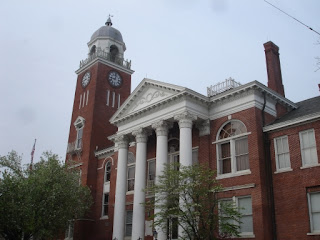
Ok, just Southwest of Fort Rucker, lies the city of Enterprise, Alabama. This city gets its fame from having the only monument in the world to an agricultural pest: The Boll Weevil Monument. (Seen above.) The following excert is from Wikipedia: "The citizens of
Enterprise, Alabama erected a monument to the boll weevil. It was, and still is, the only monument to an agricultural pest. The
boll weevil (Anthonomus grandis) was indigenous to
Mexico but appeared in
Alabama in
1915. By
1918 farmers were losing whole
cotton crops to the beetle. H. M. Sessions saw this as an opportunity to convert the area to
peanut farming. In
1916 he convinced C. W. Baston, an indebted farmer, to back his venture. The first crop paid off their debts and was bought by farmers seeking to change to peanut farming. Cotton was grown again, but farmers learned to diversify their crops, a practice which brought new money to
Coffee County. Bon Fleming, a local businessman, came up with the idea to build the monument, and helped to finance the total cost. As a tribute to how something disastrous can be a catalyst to change, the monument was dedicated on
December 11,
1919 at the intersection of College and Main Street, the heart of the town's business district. The original statue of a woman wearing a flowing gown, arms stretched above her head, was built in
Italy for approximately $1,800, not including the fountain and boll weevil. The boll weevil was not added until thirty years later, when Luther Baker thought the Boll Weevil Monument should have a boll weevil on it. He made the boll weevil and attached it to the top of the fountain that was no longer in use. The monument stands more than thirteen feet tall. The boll weevil, and sometimes even the entire monument, has been stolen many times through out the years and each time was found and repaired by the city of Enterprise until
July 11,
1998. On that day vandals ripped the boll weevil out of the statue's hands and permanently damaged the statue. City leaders were going to repair the original statue and put it back but it proved too difficult and costly. The replica still stands in downtown Enterprise, and the original is on display at Enterprise’s Depot Museum. There is a security camera nearby that monitors for further vandalism."


Coffee county courthouse

The Enterprise Depot, now a strange hodge podge of a museum, has a fascinating collection of random items, more resembling an old attic than a traditional museum.


An old washer/dryer set

An old pistol, minnie ball and ball mold

Left: old bottles, below: Old radios


An old addressing machine
Below: A carriage




The first church in Enterprise

Confederate monument
 Ok, so in the morning I headed east to the city of Bainbridge. It was once an important trading stop because of its location on the Flint river, part of the Apalachicola and Chattahoochee river system, that was vital for the southern Georgia economy. The rivers flowed through Florida's pan handle into the Gulf of Mexico and were vital enough that activities nearby sparked the first Seminole War .The city was an intriguing place, with several historic markers, and a vital starting point for seeing early sites of the first Seminole war (next post.) Above is one of a half dozen canon around Willis park downtown. Below is one of the city's war memorials.
Ok, so in the morning I headed east to the city of Bainbridge. It was once an important trading stop because of its location on the Flint river, part of the Apalachicola and Chattahoochee river system, that was vital for the southern Georgia economy. The rivers flowed through Florida's pan handle into the Gulf of Mexico and were vital enough that activities nearby sparked the first Seminole War .The city was an intriguing place, with several historic markers, and a vital starting point for seeing early sites of the first Seminole war (next post.) Above is one of a half dozen canon around Willis park downtown. Below is one of the city's war memorials.
 Memorial to Revolutionary soldiers.
Memorial to Revolutionary soldiers.

 Confederate memorial
Confederate memorial
 The other war memorial
The other war memorial Bell from the steamboat John W. Callahan
Bell from the steamboat John W. Callahan Memorial to Samuel Marvin Griffin, former govenor of Georgia
Memorial to Samuel Marvin Griffin, former govenor of Georgia Decatur county court house
Decatur county court house








 Flint river flowing to Lake Seminole
Flint river flowing to Lake Seminole This park on the west side of town had this train and some pieces of engineering equipment, but no information was given. Also a wooden walkway went through a fenced area with goats, emus, and one donkey. These could be drawn by thowing food, such as hamburger buns (below).
This park on the west side of town had this train and some pieces of engineering equipment, but no information was given. Also a wooden walkway went through a fenced area with goats, emus, and one donkey. These could be drawn by thowing food, such as hamburger buns (below).






















































